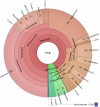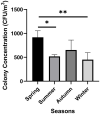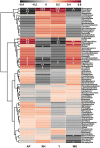Seasonal variation of airborne fungal diversity and community structure in urban outdoor environments in Tianjin, China
- PMID: 36699604
- PMCID: PMC9869124
- DOI: 10.3389/fmicb.2022.1043224
Seasonal variation of airborne fungal diversity and community structure in urban outdoor environments in Tianjin, China
Abstract
Airborne fungi are ubiquitous in human living environments and may be a source of respiratory problems, allergies, and other health issues. A 12 months study was performed to investigate the diversity, concentration and community structure of culturable airborne fungi in different outdoor environments of Tianjin City, using an HAS-100B air sampler. A total of 1,015 fungal strains belonging to 175 species and 82 genera of Ascomycota 92.5%, Basidiomycota 7%, and Mucoromycota 0.3% were isolated and identified using morphological and molecular analysis. The most abundant fungal genera were Alternaria 35%, Cladosporium 18%, Penicillium 5.6%, Talaromyces 3.9%, Didymella 3%, and Aspergillus 2.8%, while the most frequently occurring species were A. alternata (24.7%), C. cladosporioides (11%), A. tenuissima (5.3%), P. oxalicum (4.53%), and T. funiculosus (2.66%). The fungal concentration ranged from 0 to 340 CFU/m3 during the whole study. Environmental factors, including temperature, relative humidity, wind speed, and air pressure exerted a varying effect on the presence and concentration of different fungal taxa. The four analyzed seasons showed significantly different airborne fungal communities, which were more strongly influenced by air temperature and relative humidity in spring and summer, whereas wind speed and air pressure had a stronger effect in autumn and winter. Fungal communities from green and busy sites did not show significant differences over the four analyzed seasons, which may be due to the effect of the surrounding environments characterized by high human activities on the air of the relatively small parks present in Tianjin. The present study provided valuable information on the seasonal dynamics and the environmental factors shaping the diversity and concentration of the analyzed outdoor airborne fungal communities, which can be of help for air quality monitoring, microbial contamination control, and health risk assessment in urban environments.
Keywords: airborne fungi; environmental factors; fungal diversity, concentration, and community structure; green and busy urban areas; outdoor environments; seasonal variation.
Copyright © 2023 Nageen, Wang and Pecoraro.
Conflict of interest statement
The authors declare that the research was conducted in the absence of any commercial or financial relationships that could be construed as a potential conflict of interest.
Figures









Similar articles
-
A review of pathogenic airborne fungi and bacteria: unveiling occurrence, sources, and profound human health implication.Front Microbiol. 2024 Sep 19;15:1428415. doi: 10.3389/fmicb.2024.1428415. eCollection 2024. Front Microbiol. 2024. PMID: 39364169 Free PMC article. Review.
-
Analysis of culturable airborne fungi in outdoor environments in Tianjin, China.BMC Microbiol. 2021 May 2;21(1):134. doi: 10.1186/s12866-021-02205-2. BMC Microbiol. 2021. PMID: 33932997 Free PMC article.
-
Environmental Factors Affecting Diversity, Structure, and Temporal Variation of Airborne Fungal Communities in a Research and Teaching Building of Tianjin University, China.J Fungi (Basel). 2022 Apr 22;8(5):431. doi: 10.3390/jof8050431. J Fungi (Basel). 2022. PMID: 35628687 Free PMC article.
-
Analysis of Airborne Fungal Communities on Pedestrian Bridges in Urban Environments.Microorganisms. 2023 Aug 16;11(8):2097. doi: 10.3390/microorganisms11082097. Microorganisms. 2023. PMID: 37630657 Free PMC article.
-
Airborne bacterial communities of outdoor environments and their associated influencing factors.Environ Int. 2020 Dec;145:106156. doi: 10.1016/j.envint.2020.106156. Epub 2020 Oct 8. Environ Int. 2020. PMID: 33039877 Review.
Cited by
-
The influence of car traffic on airborne fungal diversity in Tianjin, China.Mycology. 2024 Jan 18;15(3):506-520. doi: 10.1080/21501203.2023.2300343. eCollection 2024. Mycology. 2024. PMID: 39247890 Free PMC article.
-
Hospital distribution, seasonality, time trends and antifungal susceptibility profiles of all Aspergillus species isolated from clinical samples from 2015 to 2022 in a tertiary care hospital.BMC Microbiol. 2024 Apr 3;24(1):111. doi: 10.1186/s12866-024-03267-8. BMC Microbiol. 2024. PMID: 38570761 Free PMC article.
-
Bayesian analysis suggests independent development of sensitization to different fungal allergens.World Allergy Organ J. 2024 May 17;17(5):100908. doi: 10.1016/j.waojou.2024.100908. eCollection 2024 May. World Allergy Organ J. 2024. PMID: 38800499 Free PMC article.
-
A review of pathogenic airborne fungi and bacteria: unveiling occurrence, sources, and profound human health implication.Front Microbiol. 2024 Sep 19;15:1428415. doi: 10.3389/fmicb.2024.1428415. eCollection 2024. Front Microbiol. 2024. PMID: 39364169 Free PMC article. Review.
-
Public health implications of bacterial and fungal bioaerosol concentrations in outdoor air.Sci Rep. 2025 Jul 2;15(1):22706. doi: 10.1038/s41598-025-08196-8. Sci Rep. 2025. PMID: 40593141 Free PMC article.
References
-
- Aira M. J., Jato V., Stchigel A. M., Rodríguez-Rajo F. J., Piontelli E. (2007). Aeromycological study in the Cathedral of Santiago de Compostela (Spain). Int. Biodeterior. Biodegradation 60, 231–237. doi: 10.1016/j.ibiod.2007.02.007 - DOI
LinkOut - more resources
Full Text Sources

